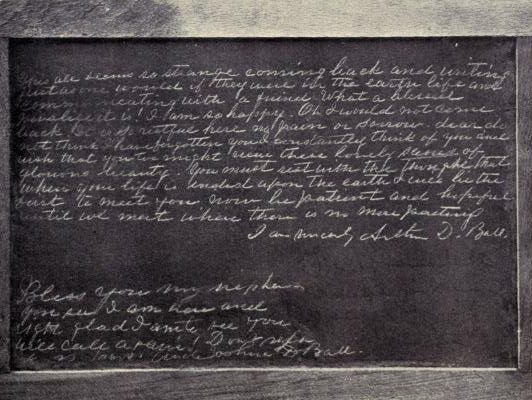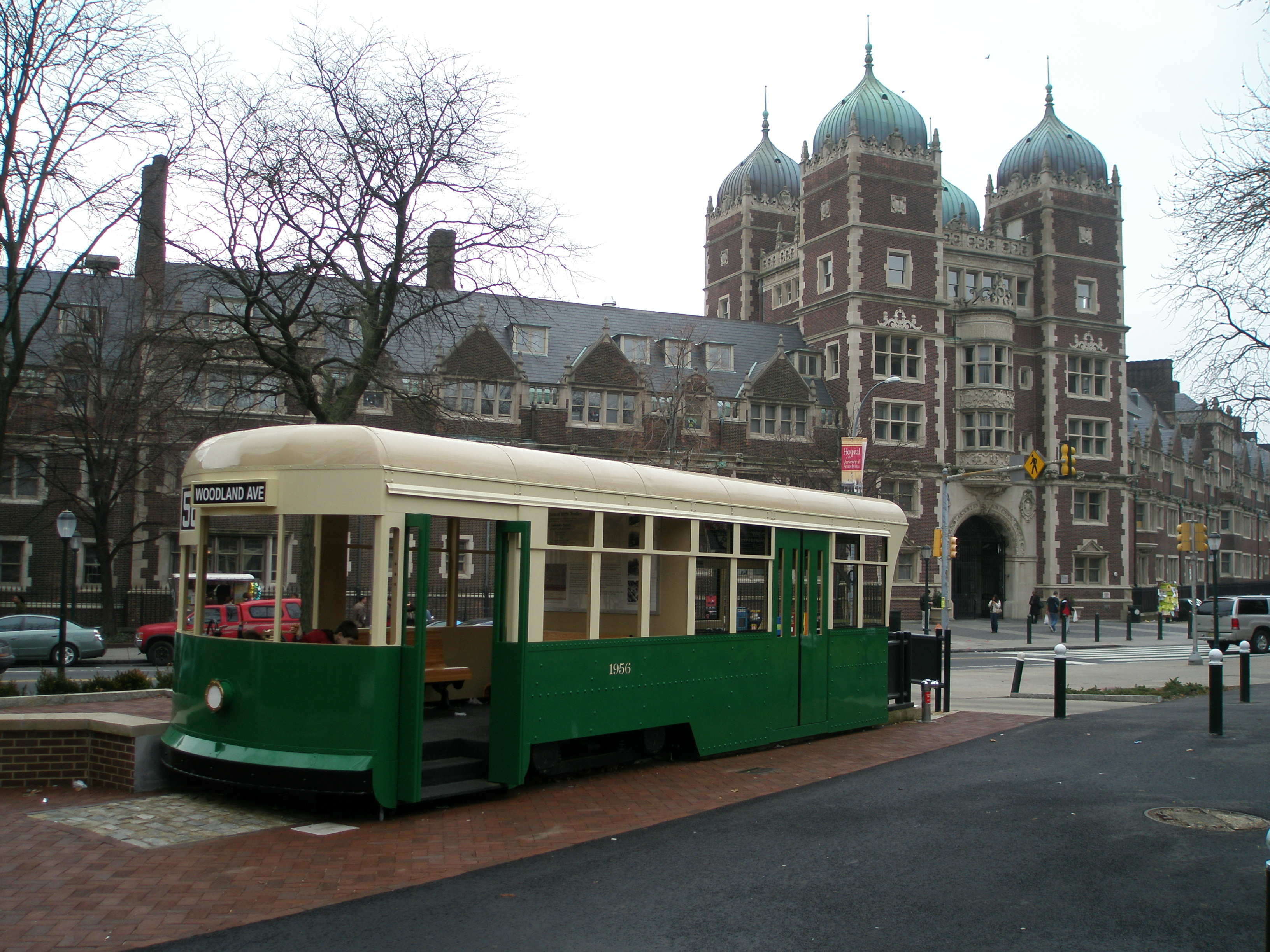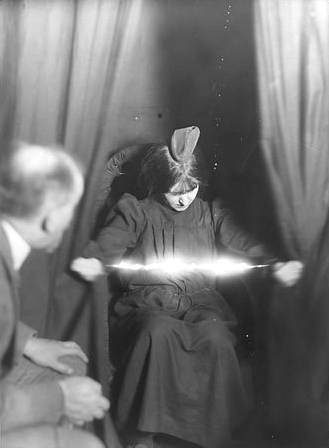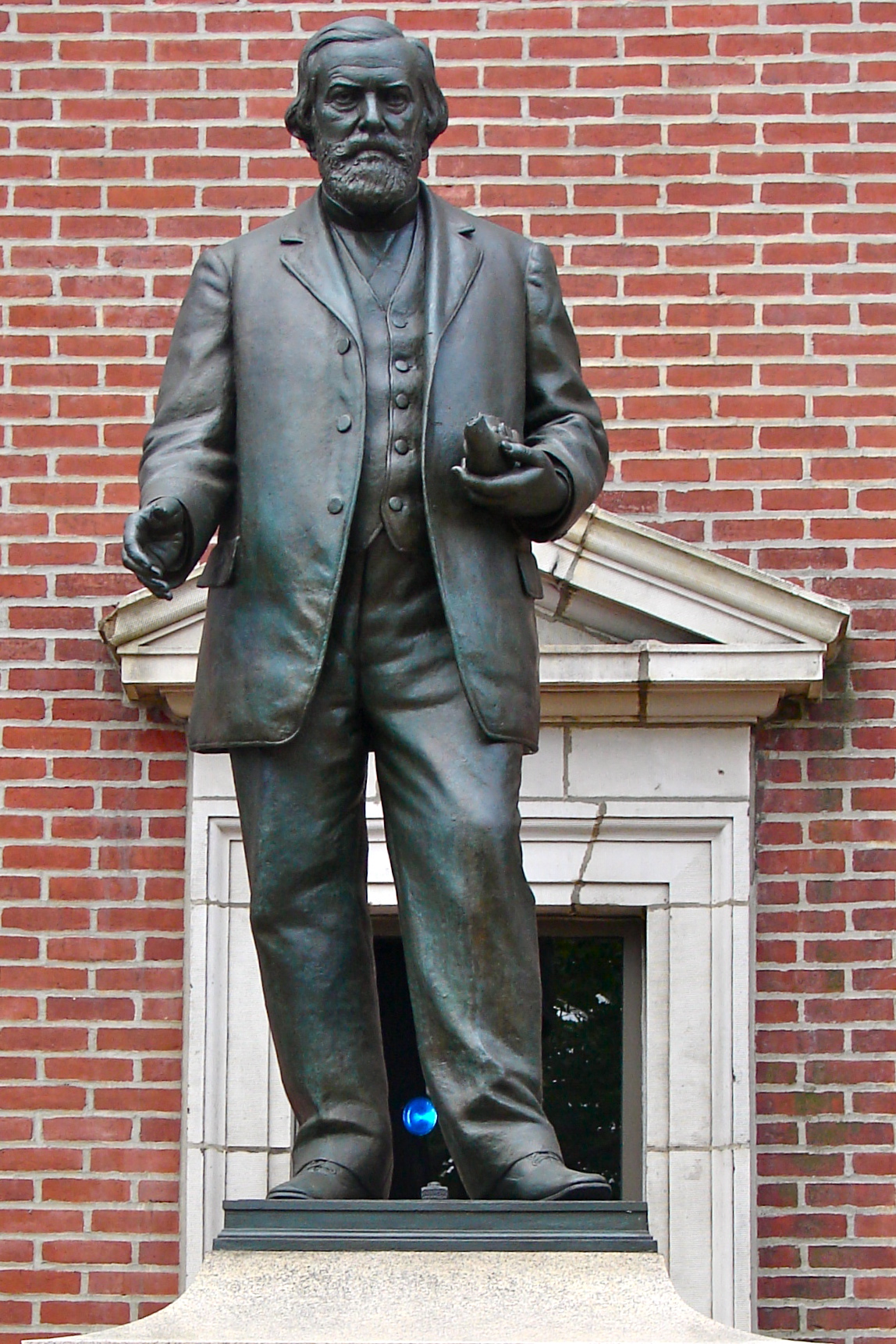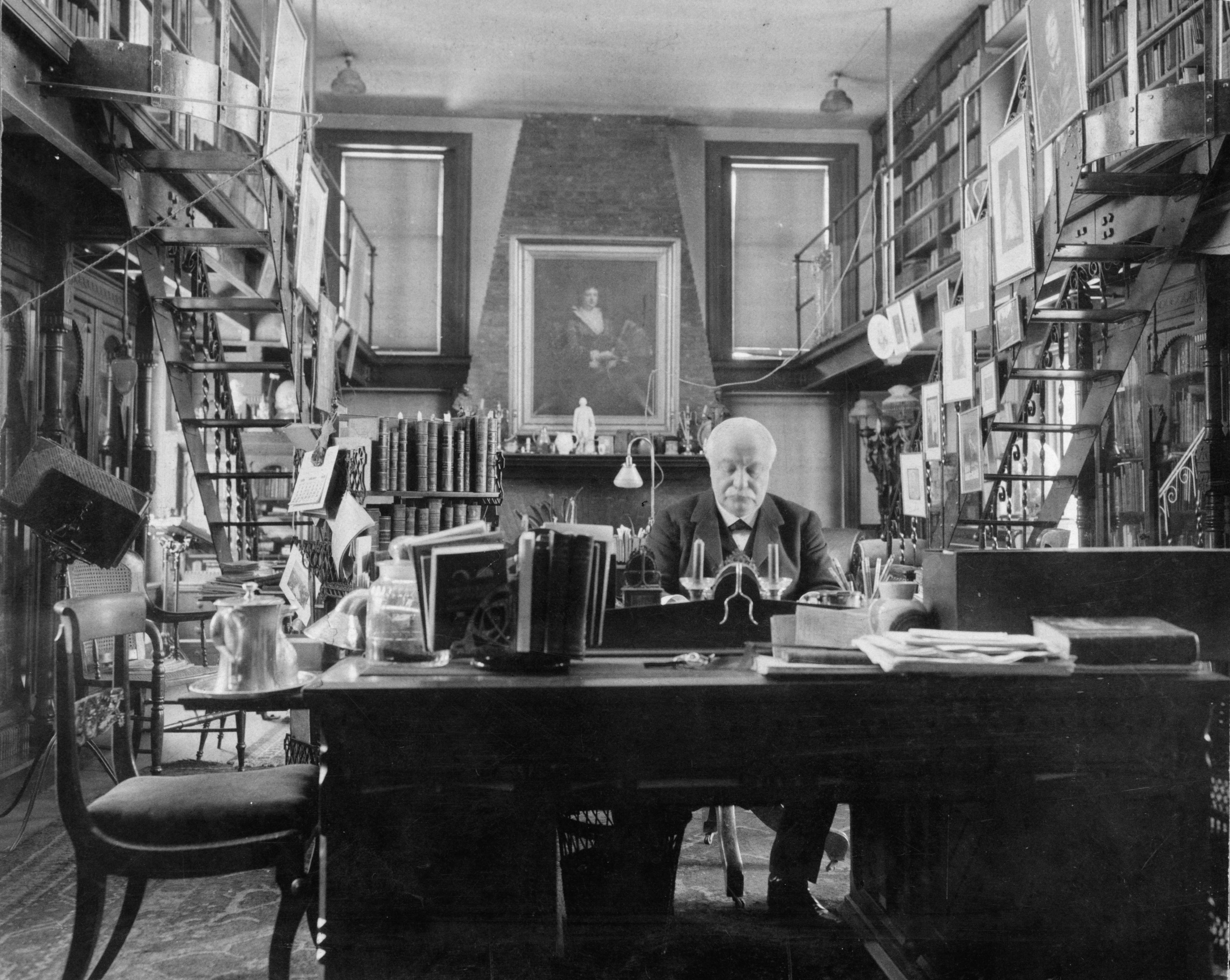|
Seybert Commission
The Seybert Commission was a group of faculty members at the University of Pennsylvania who in 1884–1887 investigated a number of respected Spiritualist mediums, uncovering fraud or suspected fraud in every case that they examined. Establishment of the Commission An ardent believer in Spiritualism, Henry Seybert left in his will funds for the establishment of an endowed chair in Philosophy at the University of Pennsylvania. As a condition to this bequest, he required that the University set up a commission to investigate "all systems of Morals, Religion, or Philosophy which assume to represent the Truth, and particularly of Modern Spiritualism." Ten men served on the commission, all of whom declared themselves at the outset to either be neutral or favorably disposed toward Spiritualism. Among the more notable members were the University Provost William Pepper (a physician), the paleontologist Joseph Leidy, the Shakespearean scholar Horace Howard Furness (who served as the cha ... [...More Info...] [...Related Items...] OR: [Wikipedia] [Google] [Baidu] |
University Of Pennsylvania
The University of Pennsylvania (Penn or UPenn) is a Private university, private Ivy League research university in Philadelphia, Pennsylvania, United States. One of nine colonial colleges, it was chartered in 1755 through the efforts of founder and first president Benjamin Franklin, who had advocated for an educational institution that trained leaders in academia, commerce, and public service. The university has four undergraduate schools and 12 graduate and professional schools. Schools enrolling undergraduates include the College of Arts and Sciences, the University of Pennsylvania School of Engineering and Applied Science, School of Engineering and Applied Science, the Wharton School, and the University of Pennsylvania School of Nursing, School of Nursing. Among its graduate schools are its University of Pennsylvania Law School, law school, whose first professor, James Wilson (Founding Father), James Wilson, helped write the Constitution of the United States, U.S. Cons ... [...More Info...] [...Related Items...] OR: [Wikipedia] [Google] [Baidu] |
Spiritualism (movement)
Spiritualism is a social religious Social movement, movement popular in the nineteenth and early twentieth centuries, according to which an individual's Afterlife, awareness persists after death and may be Séance, contacted by the living. The afterlife, or the "Spirit world (Spiritualism), spirit world", is seen by spiritualists not as a static place, but as one in which spirits continue to interact and evolve. These two beliefs—that contact with spirits is possible, and that spirits are more advanced than humans—lead spiritualists to the belief that spirits are capable of advising the living on morality, moral and ethical issues and the nature of God. Some spiritualists follow "spirit guides"—specific spirits relied upon for spiritual direction... Emanuel Swedenborg has some claim to be the father of spiritualism. The movement developed and reached its largest following from the 1840s to the 1920s, especially in English-speaking countries.. It flourished for a half centur ... [...More Info...] [...Related Items...] OR: [Wikipedia] [Google] [Baidu] |
Mediumship
Mediumship is the practice of purportedly mediating communication between familiar spirits or ghost, spirits of the dead and living human beings. Practitioners are known as "mediums" or "spirit mediums". There are different types of mediumship or spirit conduit (channeling), channelling, including table-turning, séance tables, trance, and ouija. The practice is associated with Spiritualism (movement), spiritualism and Kardecist spiritism, spiritism. A similar New Age practice is known as Channeling (New Age), channeling. Belief in psychic ability is widespread despite the absence of empirical evidence for its existence. Scientific researchers have attempted to ascertain the validity of claims of mediumship for more than one hundred years and have consistently failed to confirm them. As late as 2005, an experiment undertaken by the British Psychological Society reaffirmed that test subjects who self-identified as mediums demonstrated no mediumistic ability. Mediumship gained popu ... [...More Info...] [...Related Items...] OR: [Wikipedia] [Google] [Baidu] |
William Pepper
William Pepper Jr. (August 21, 1843July 28, 1898), was an American physician and medical educator, and the eleventh provost of the University of Pennsylvania, from 1881 to 1894. He was an advocate for the establishment of a university affiliated hospital and led the finance and building committees for the construction of the University of Pennsylvania Hospital in 1874. As provost, he oversaw a major expansion of the University including the construction of 13 campus buildings, the addition of the Wharton School of Business, and eleven new departments. In 1891, he founded the Free Library of Philadelphia. Early life and education Pepper was born in Philadelphia to Dr. William Pepper Sr. and Sarah Platt. He was educated at the University of Pennsylvania and graduated with a Bachelor's degree as valedictorian in 1862 and from the medical school in 1864. He received a LL.D. degree from Lafayette College in 1881 and from the University of Pennsylvania in 1893. Career Pepper worke ... [...More Info...] [...Related Items...] OR: [Wikipedia] [Google] [Baidu] |
Joseph Leidy
Joseph Mellick Leidy (September 9, 1823 – April 30, 1891) was an American paleontologist, parasitologist and anatomist. Leidy was professor of anatomy at the University of Pennsylvania, later becoming a professor of natural history at Swarthmore College and the director of scientific and educational programs at the Wagner Free Institute of Science. His book ''Extinct Fauna of Dakota and Nebraska'' (1869) contained many species not previously described and many previously unknown on the North American continent. At the time, scientific investigation was largely the province of wealthy amateurs. The Leidy Glacier in northwest Greenland was named by Robert Peary after him. Early life and family Joseph Leidy was born on September 9, 1823, to an established Philadelphia family of Pennsylvania Germans. His father, Philip, was a hatter; his mother, Catharine, died during childbirth when he was young. His father then married his wife's first cousin, Christiana Mellick. Leidy al ... [...More Info...] [...Related Items...] OR: [Wikipedia] [Google] [Baidu] |
Horace Howard Furness
Horace Howard Furness (November 2, 1833 – August 13, 1912) was an American Shakespearean scholar of the 19th century. Life and career Horace Furness was the son of the Unitarian minister and abolitionist William Henry Furness (1802–1896), and brother of the architect Frank Furness (1839–1912). He graduated from Harvard University in 1854, embarked on a journey to Europe with Atherton Blight, and then studied in Germany. After returning to the United States, he was admitted to the Philadelphia Bar in 1858, but his growing deafness interfered with the practice of law. In 1860, he joined the Shakspere Society of Philadelphia, an amateur study group that took its scholarship seriously. As he later wrote: As editor of the "New Variorum" editions of Shakespeare—also called the "Furness Variorum"—he collected in a single source 300 years of references, antecedent works, influences and commentaries. He devoted more than forty years to the series, completing the annotat ... [...More Info...] [...Related Items...] OR: [Wikipedia] [Google] [Baidu] |
Silas Weir Mitchell (physician)
Silas Weir Mitchell (February 15, 1829 – January 4, 1914) was an American physician, scientist, novelist, and poet. He is considered the father of medical neurology, and he discovered causalgia (complex regional pain syndrome) and erythromelalgia, and pioneered the rest cure. Early life Silas Weir Mitchell was born on February 15, 1829, in Philadelphia, Pennsylvania, to prominent physician and writer John Kearsley Mitchell (1792–1858) and Sarah Henry Mitchell (1800–1872) . His father was a doctor and pathologist interested in snake venom, and Mitchell would continue his research later on. Dr. Mitchell studied at the University of Pennsylvania and later earned the degree of MD at the city's Jefferson Medical College in 1850. Career During the Civil War, he was director of treatment of nervous injuries and maladies at Turner's Lane Hospital, Philadelphia, and at the close of the war became a specialist in neurology. In this field Mitchell pioneered the rest cure for ... [...More Info...] [...Related Items...] OR: [Wikipedia] [Google] [Baidu] |
Slate Writing Example
Slate is a fine-grained, foliated, homogeneous, metamorphic rock derived from an original shale-type sedimentary rock composed of clay or volcanic ash through low-grade, regional metamorphism. It is the finest-grained foliated metamorphic rock. Foliation may not correspond to the original sedimentary layering, but instead is in planes perpendicular to the direction of metamorphic compression. The foliation in slate, called " slaty cleavage", is caused by strong compression in which fine-grained clay forms flakes to regrow in planes perpendicular to the compression. When expertly "cut" by striking parallel to the foliation with a specialized tool in the quarry, many slates display a property called fissility, forming smooth, flat sheets of stone which have long been used for roofing, floor tiles, and other purposes. Slate is frequently grey in color, especially when seen ''en masse'' covering roofs. However, slate occurs in a variety of colors even from a single locality; for e ... [...More Info...] [...Related Items...] OR: [Wikipedia] [Google] [Baidu] |
Henry Slade (medium)
Henry Slade (1835–1905) was a famous fraudulent medium who lived and practiced in both Europe and North America. Slade was best known for his "slate writing" method, where he would purportedly produce messages written by spirits on slates. Biography Slade was most well known as a slate-writing medium. During his séances he would place a small slate with a piece of chalk under a table and would claim spirits would use it to write messages. According to Joe Nickell, Slade was repeatedly caught faking the spirit messages in his séances and he produced his phenomena by a variety of magic tricks. Science writer Karen Stollznow has noted that: In 1872, Slade was caught in fraud in New York by John W. Truesdell, who had two sittings with him. During the séance Truesdell observed Slade using his foot to move objects under the table, and writing on a slate. In a séance Stanley LeFevre Krebs employed a secret mirror and caught Slade swapping slates and hiding them in the b ... [...More Info...] [...Related Items...] OR: [Wikipedia] [Google] [Baidu] |
Pierre L
Pierre is a masculine given name. It is a French form of the name Peter. Pierre originally meant "rock" or "stone" in French (derived from the Greek word πέτρος (''petros'') meaning "stone, rock", via Latin "petra"). It is a translation of Aramaic כיפא (''Kefa),'' the nickname Jesus gave to apostle Simon Bar-Jona, referred in English as Saint Peter. Pierre is also found as a surname. People with the given name * Monsieur Pierre, Pierre Jean Philippe Zurcher-Margolle (c. 1890–1963), French ballroom dancer and dance teacher * Pierre (footballer), Lucas Pierre Santos Oliveira (born 1982), Brazilian footballer * Pierre, Baron of Beauvau (c. 1380–1453) * Pierre, Duke of Penthièvre (1845–1919) * Pierre, marquis de Fayet (died 1737), French naval commander and Governor General of Saint-Domingue * Prince Pierre, Duke of Valentinois (1895–1964), father of Rainier III of Monaco * Pierre Affre (1590–1669), French sculptor * Pierre Agostini, French physicist * ... [...More Info...] [...Related Items...] OR: [Wikipedia] [Google] [Baidu] |
William M
William is a masculine given name of Germanic origin. It became popular in England after the Norman conquest in 1066,All Things William"Meaning & Origin of the Name"/ref> and remained so throughout the Middle Ages and into the modern era. It is sometimes abbreviated "Wm." Shortened familiar versions in English include Will or Wil, Wills, Willy, Willie, Bill, Billie, and Billy. A common Irish form is Liam. Scottish diminutives include Wull, Willie or Wullie (as in Oor Wullie). Female forms include Willa, Willemina, Wilma and Wilhelmina. Etymology William is related to the German given name ''Wilhelm''. Both ultimately descend from Proto-Germanic ''*Wiljahelmaz'', with a direct cognate also in the Old Norse name ''Vilhjalmr'' and a West Germanic borrowing into Medieval Latin ''Willelmus''. The Proto-Germanic name is a compound of *''wiljô'' "will, wish, desire" and *''helmaz'' "helm, helmet".Hanks, Hardcastle and Hodges, ''Oxford Dictionary of First Names'', Oxfor ... [...More Info...] [...Related Items...] OR: [Wikipedia] [Google] [Baidu] |
Spirit Photography
Spirit(s) commonly refers to: * Liquor, a distilled alcoholic drink * Spirit (animating force), the non-corporeal essence of living things * Spirit (supernatural entity), an incorporeal or immaterial being Spirit(s) may also refer to: Liquids * Tincture, an extract of plant or animal material dissolved in ethanol * Cologne spirit, also known as drinking alcohol * Petroleum spirit (other) ** Motor spirit, a clear petroleum-derived flammable liquid that is used primarily as a fuel ** Petroleum ether, liquid hydrocarbon mixtures used chiefly as non-polar solvents ** White spirit or mineral spirits, a common organic solvent used in painting and decorating Philosophy, religion and folklore *Spirituality, pertaining to the soul or spirit *Holy Spirit, a divine force, manifestation of God in the Holy Trinity, or agent of divine action, according to Abrahamic Religions * Great Spirit, conception of a supreme being prevalent among some Native American and First Nati ... [...More Info...] [...Related Items...] OR: [Wikipedia] [Google] [Baidu] |
